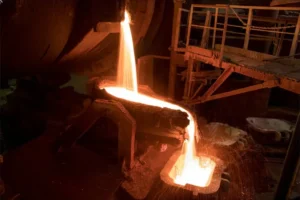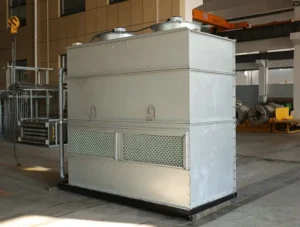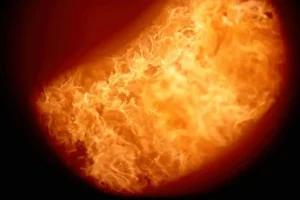Lò nung cảm ứng, Là một công nghệ sưởi ấm nâng cao, đóng vai trò then chốt trong việc đạt được các mục tiêu phát triển bền vững.
Chúng góp phần đáng kể vào việc xây dựng một môi trường xanh hơn, Hệ thống sản xuất công nghiệp hiệu quả hơn bằng cách giảm lượng khí thải carbon, nâng cao hiệu quả sử dụng tài nguyên, Và thúc đẩy một kinh tế tuần hoàn.
Giảm lượng khí thải carbon
Lò nung cảm ứng góp phần giảm lượng khí thải carbon theo nhiều cách.
- Cao Hiệu suất năng lượng và tiêu thụ năng lượng thấp: Nguyên lý gia nhiệt cảm ứng liên quan đến việc tạo nhiệt trực tiếp trong phôi thông qua cảm ứng điện từ., thay vì truyền nhiệt qua môi trường bên ngoài. Phương pháp gia nhiệt trực tiếp này làm giảm đáng kể sự thất thoát nhiệt, dẫn đến sự cải thiện đáng kể về hiệu quả sử dụng năng lượng. So với lò đốt than hoặc gas truyền thống, lò cảm ứng có thể đạt được hiệu quả năng lượng ấn tượng 60% ĐẾN 80%, vượt xa 30%-50% hoặc thậm chí hiệu suất thấp hơn của lò điện trở truyền thống. Hiệu suất năng lượng cao hơn có nghĩa là cần ít năng lượng hơn để hoàn thành cùng một nhiệm vụ sưởi ấm, trực tiếp giảm lượng khí thải carbon từ sản xuất năng lượng.
- Năng lượng sạch Lựa chọn: Lò nung cảm ứng sử dụng điện làm nguồn năng lượng, và điện có thể được tạo ra từ nhiều nguồn năng lượng sạch khác nhau (chẳng hạn như năng lượng mặt trời, gió, và thủy điện). Khi đầu tư toàn cầu vào và sử dụng năng lượng tái tạo tiếp tục tăng, lò cảm ứng có thể tích hợp tốt hơn với các nguồn năng lượng sạch này, tiếp tục giảm lượng khí thải carbon hoạt động của họ. Khi nguồn điện có thể tái tạo, lượng khí thải carbon từ lò cảm ứng gần như bằng không.
- Kiểm soát nhiệt độ chính xác, Giảm quá nhiệt: Lò nung cảm ứng cho phép điều khiển chính xác Và phản ứng nhanh đến nhiệt độ gia nhiệt. Điều này có nghĩa là nhiệt độ gia nhiệt có thể được đặt chính xác theo nhu cầu sản xuất, tránh quá nhiệt không cần thiết và do đó tiết kiệm năng lượng. Ví dụ, trong quá trình xử lý nhiệt kim loại, lò nung truyền thống có thể yêu cầu thời gian làm nóng trước lâu hơn và chịu tổn thất nhiệt cao hơn, trong khi lò cảm ứng có thể đạt đến nhiệt độ mong muốn gần như ngay lập tức, rút ngắn đáng kể thời gian gia nhiệt và giảm tiêu thụ năng lượng.
- Không đốt cháy, KHÔNG Khí thải Khí thải: Không giống như lò đốt than hoặc gas, Lò nung cảm ứng không tạo ra bất kỳ khí thải đốt nào, chẳng hạn như carbon dioxide, lưu huỳnh đioxit, hoặc oxit nitơ, trong quá trình gia nhiệt. Điều này không chỉ giúp giảm phát thải khí nhà kính mà còn ngăn chặn việc tạo ra các chất gây ô nhiễm không khí, điều quan trọng để cải thiện chất lượng không khí.
Cải thiện hiệu quả sử dụng tài nguyên
Lò nung cảm ứng tăng cường sử dụng tài nguyên thông qua các phương pháp sau.
- Năng suất vật liệu cao hơn: Trong quá trình nấu chảy và đúc kim loại, Kiểm soát nhiệt độ chính xác và đặc tính gia nhiệt đồng đều của lò nung cảm ứng làm giảm hiệu quả tổn thất oxy hóa kim loại và sự bay hơi của các nguyên tố hợp kim. Ví dụ, khi nấu chảy thép, lò nung truyền thống có thể có tỷ lệ đốt cháy trên 5%, trong khi lò nung cảm ứng có thể kiểm soát tốc độ này để ít hơn 1%, tăng đáng kể năng suất kim loại và giảm lãng phí nguyên liệu thô.
- Giảm Tỷ lệ phế liệu: Kiểm soát nhiệt độ chính xác và đồng đều nhiệt cho phép lò cảm ứng kiểm soát chất lượng sản phẩm tốt hơn. Trong các ứng dụng như xử lý nhiệt và rèn, tỷ lệ phế liệu do gia nhiệt không đều hoặc sai lệch nhiệt độ giảm đáng kể. Ví dụ, trong quá trình làm nguội các linh kiện ô tô, quá trình làm nguội cảm ứng đảm bảo tính đồng nhất và độ sâu của lớp cứng, giảm số lượng các bộ phận bị loại bỏ do vấn đề chất lượng.
- Tuổi thọ của khuôn và dụng cụ được kéo dài: Trong các quá trình như rèn và đúc khuôn, gia nhiệt cảm ứng cung cấp một quá trình gia nhiệt đồng đều hơn và có thể kiểm soát được, giúp giảm ứng suất nhiệt lên khuôn và dụng cụ. So với lò nung truyền thống, gia nhiệt cảm ứng có thể kéo dài tuổi thọ của khuôn và dụng cụ bằng cách 10% ĐẾN 30%, do đó làm giảm nhu cầu về khuôn mẫu và công cụ mới trong quá trình sản xuất và bảo tồn tài nguyên.
Thúc đẩy nền kinh tế tuần hoàn
Lò nung cảm ứng góp phần thúc đẩy nền kinh tế tuần hoàn chủ yếu thông qua.
- Tái chế hiệu quả phế liệu kim loại: Lò nung cảm ứng là thiết bị lý tưởng cho tái chế và tái sử dụng kim loại phế liệu. Họ có thể nấu chảy nhiều loại thép phế liệu một cách hiệu quả, gang thép, và nhôm, biến chúng thành kim loại tái chế chất lượng cao để sản xuất các sản phẩm mới. Do tốc độ gia nhiệt nhanh và hiệu suất nấu chảy cao, lò cảm ứng được sử dụng rộng rãi trong ngành tái chế kim loại phế liệu, cung cấp hỗ trợ kỹ thuật quan trọng cho việc sử dụng tuần hoàn các nguồn tài nguyên kim loại. Trong ngành thép, Ví dụ, nấu chảy thép phế liệu thành thép mới bằng lò cảm ứng có thể làm giảm đáng kể nhu cầu khai thác các nguồn tài nguyên nguyên chất như quặng sắt, giảm tiêu thụ tài nguyên và tác động môi trường.
- Tạo điều kiện tái sinh vật liệu: Ngoài kim loại, Công nghệ gia nhiệt cảm ứng cũng được áp dụng để tái sinh các vật liệu khác, chẳng hạn như tái chế và tái xử lý nhựa. Thông qua sưởi ấm cảm ứng, có thể đạt được sự nấu chảy và tạo hình chính xác của nhựa tái chế, cho phép họ lấy lại tiện ích của mình, từ đó giảm phát sinh rác thải nhựa và thúc đẩy nền kinh tế tuần hoàn nhựa.
- Giảm phát sinh chất thải: Như đã đề cập ở trên, bằng cách cải thiện năng suất vật liệu và giảm tỷ lệ phế liệu, lò cảm ứng trực tiếp giảm chất thải phát sinh trong quá trình sản xuất. Hơn nữa, do tính chất không cháy của chúng, Bản thân lò nung cảm ứng không tạo ra chất thải rắn công nghiệp, tiếp tục giảm bớt gánh nặng môi trường.
- Kéo dài tuổi thọ sản phẩm: Thông qua công nghệ xử lý nhiệt cảm ứng, sức mạnh, độ cứng, và khả năng chống mài mòn của các thành phần kim loại có thể được cải thiện đáng kể, qua đó kéo dài tuổi thọ sử dụng của sản phẩm. Ví dụ, trục khuỷu và bánh răng ô tô được xử lý bằng tôi cảm ứng cho thấy độ bền được tăng cường đáng kể, giảm tần suất thay thế linh kiện và do đó nhu cầu sản xuất sản phẩm mới và phát sinh chất thải. Điều này hoàn toàn phù hợp với “kéo dài tuổi thọ sản phẩm” khái niệm về nền kinh tế tuần hoàn.
Lò nung cảm ứng, với hiệu quả của họ, lau dọn, và đặc điểm chính xác, chứng minh những lợi ích đáng kể trong việc giảm lượng khí thải carbon, nâng cao hiệu quả sử dụng tài nguyên, và thúc đẩy nền kinh tế tuần hoàn.
Chúng không chỉ là những hỗ trợ công nghệ quan trọng cho quá trình chuyển đổi công nghiệp theo hướng phát triển bền vững mà còn góp phần đáng kể vào việc đạt được các mục tiêu về khí hậu toàn cầu và xây dựng một xã hội tiết kiệm tài nguyên.







